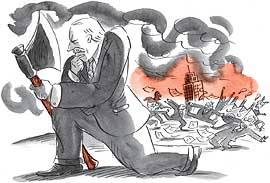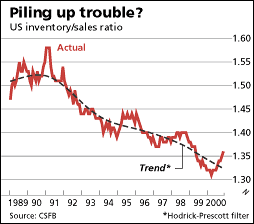
New
economy or old, the slowdown is confronting corporate America with a
familiar
question: which costs to cut, and how deeply?
 |
THE downturn that is already gripping America has removed the last shreds of credibility from the ultra-optimistic “new economy” theories once espoused by Wall Street’s and Silicon Valley’s most gung-ho believers. Thanks to wondrous new technology, the business cycle was supposedly consigned to the history books, and productivity would grow forever at a miraculous rate. So much for that: in the fourth quarter of last year, labour productivity grew at an annual rate of 2.4%, well down from the 4.3% for 2000 as a whole. Will the slowdown prompt company bosses to start cutting jobs and investment, making recession a certainty?
If anybody should doubt that the downturn is real, Cisco, a technology bellwether, this week missed its earnings expectations for the first time in over six years. According to John Chambers, its chief executive, spending by businesses on high-tech gear “could get worse before it starts to improve”. Likewise, News Corporation, a media group, has just announced a loss in the past quarter. The pain is even being felt in the executive suite: Korn/Ferry, an executive search firm, has warned of weaker profits because its clients are hiring fewer people.
In past
recessions,
productivity plunged because businesses could not adjust quickly enough
to falling demand. Firms tended to keep large inventories around to
smooth
out the failings in their crude demand forecasts. Crippled by excess
inventories,
they would lay off workers, prompting consumer confidence and spending
to evaporate in a vicious recessionary circle. The new economy was
supposed
to be different. The extraordinary investment in information technology
over the past decade brought in far more flexible manufacturing and
just-in-time
supply-chain systems designed to identify and respond to shocks quickly
and smoothly, flattening the business cycle, if not banishing it.
 |
Yet in recent months, inventories have risen sharply (see chart), suggesting that even today’s supply chains are not perfectly nimble. How worrying is this? In previous recessions, inventory as a percentage of sales spiked alarmingly. Because this ratio has been on a strong downward trend during the past decade, the recent spike is to a much lower level than before. Nonetheless, economists at CSFB point out that, adjusted for this trend, the recent rise in inventories is the biggest since the recession of 1990-91.
Manufacturers may now be reacting more rapidly to a rise in inventories than in the past by cutting production. The National Association of Purchasing Managers (NAPM) index of new orders plunged in January to a 10-year low. This is a reliable leading indicator of future industrial production and, says CSFB, “suggests a massive response to excess inventory is in the pipeline” compared with past downturns.
This
all
looks rather bleak. If manufacturers get their inventories down as fast
as possible, the fall in output could be large enough to ensure the
economy
has the two consecutive quarters of contraction that are needed to
count
officially as a recession. Worse, the manufacturing correction would
influence
managers throughout the economy to retrench, which could then deepen
the
recession into something even worse. The NAPM non-manufacturing orders
index plunged in January after previously holding up well, suggesting
that
a recession mindset may be spreading to the service sector.
Two sorts of cuts now being agonised over by bosses—to investment and to the workforce—will prove crucial in the coming months. Capital spending has soared to 15.4% of America’s GDP, up from 9.5% a decade ago. Over half of that is IT spending. In terms of its contribution to growth, this investment is even more significant: in the past five years, business spending on technology-related equipment and software accounted for one-third of real GDP growth.
Already, business investment has started to edge lower. Stephen Roach, an economist at Morgan Stanley, thinks it could soon fall much more rapidly. He is sceptical of claims that IT investment will prove immune from the slowdown because companies will feel they have to keep pace with technological change—he calls such talk “vendor-driven hype”. More likely, he says, firms will realise they do not need to upgrade their e-mail software every other week, or invest regularly in state-of-the-art servers.
What, then, of job cuts? A recent crop of headlines about lay-offs at big companies, such as GE and DaimlerChrysler, gives a misleading impression of aggressive axe-wielding. It is true that things could yet turn fierce in the labour market. Some 134,000 jobs were reportedly eliminated in December, the most in a single month for eight years, according to Challenger, Gray and Christmas, an outplacement firm. January may have been even worse. Yet many of the announced cuts were for long-term strategic reasons—such as GE’s merger integration with Honeywell—rather than because of the downturn, and will take place over several years, mostly through attrition.
The lack of job cuts so far may disappoint those new-economy theorists who reckon that today’s information systems and flexible labour market should have led to a speedy response. As Ian Shepherdson of High Frequency Economics points out, if firms had cut workers by enough to maintain the sort of productivity growth they enjoyed in the first half of 2000, unemployment, currently 4.2% of the workforce, would by now exceed 5%. Instead, firms have been “hoarding” workers. Perhaps this should not surprise new-economy believers. After all, in this economy, human capital is supposed to be a firm’s greatest asset, so to jettison it at the first sign of trouble would be horribly short-sighted.
Labour-market flexibility is making it easier to hoard labour. Charles Schwab, a brokerage, has demonstrated this well by telling many of its workers to take days of unpaid leave rather than cutting jobs. According to Ethan Harris, an economist at Lehman Brothers, the spread of profit-related pay and flexible working hours has enabled firms to adjust quickly to slowing demand with far fewer lay-offs than would have occurred in past downturns. The proportion of workers on flexible hours has nearly doubled since 1991, to almost 30%, and two-thirds of all workers now earn some variable pay (bonus, profit share and so on).
Even as they hoard their most valued workers, companies can more readily shed temporary staff, who now account for nearly 3% of the workforce, up from 1.3% in 1990. Manpower, America’s largest temp agency, experienced flat sales in the fourth quarter of last year, down from 7% growth year-on-year in the third quarter, as demand from manufacturers plummeted. Jeffrey Joerres, Manpower’s chief executive, says the first quarter of this year is also likely to be flat, although he takes some comfort from the fact that, so far this year, things have got no worse, and weakness is confined mostly to manufacturing.
The next few weeks will determine whether a correction in manufacturing turns into something nastier. What is already clear, and makes worse scenarios more likely, is that growth in corporate profits is certain to slow this year, recession or not, due to sluggish growth in demand, rising interest costs (caused by refinancings of debt secured when long-term interest rates were lower than today) and accelerating depreciation costs. According to Bank Credit Analyst, an insightful newsletter, even if America can avoid recession, annual profit growth is likely to turn negative this year; and if there is a recession on the scale of 1990-91, operating profits could fall by as much as 15%. The need to stop profits tumbling may lead company bosses, ever mindful of their share options, to act ruthlessly—and thereby make a recession not likely but certain.